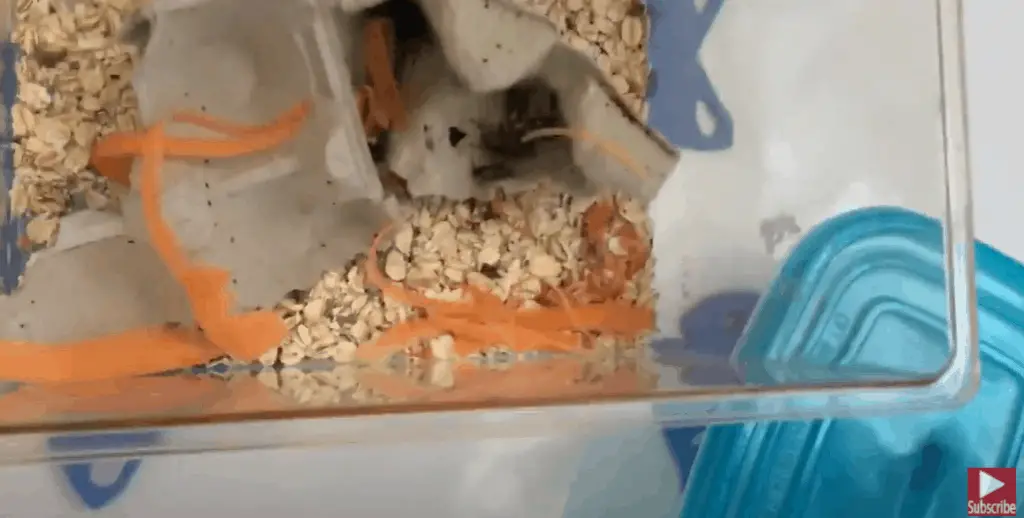Are Chameleons Hard to Take Care Of?
As a general Rule Chameleons are not that hard to take care of once you have their setup correct. Their care includes Safe Enclosure, Food, Water, Light, Correct temperatures, and veterinarian Checkups. Once you have these they are fairly Maintenance-Free Pets
Species Summary
Chameleons are amazing reptiles. They are known for their abundance of colors and their color-changing abilities. The ability they have to have independently rotating eyes is very unique. Are Chameleons Hard to Take Care Of?
Their majestic name “Chameleon” comes from Two Greek words (χαμαιλέων (khamailéōn)), meaning “Lion / On the Ground.”
They have an Extremely long tong that they can launch with the procession for their meals. Their tongues are a unique combination of Bone, Elastic elements, and muscles. They can shoot their tongues up to two body lengths from their mouths. It is done at a speed of approximately 13 MPH.
- There are 202 Species of Chameleons, mostly originating in the African Continent
- Quite a few are on the endangered list, so they are quite precious.
- The Family of Reptiles they Belong to – Chamaeleonidae

Appearance & Colors
Chameleons have an amazing ability to change colors. For many years scientists thought that they were adapting their colors to blend into their surroundings. Now scientists believe that they change color as a means of communication with each other.
When males are being territorial, they change colors as a means of aggression. Males also Change colors when they are courting a female. If a Female is not interested in their advances or she is carrying eggs, will show vibrant colors to turn back a male’s advances.
Color Changing ability
In 2015 scientists (physicist & Biologist) discovered that in the outside layer of skin of the chameleon there are several pigments (melanin). These are pigment crystals, and the chameleon actively changes color by changing the proximity of these cells to each other, tightening or stretching them allow Chameleons to change color.
Expert Chameleon Tip – When a Chameleon changes its color it is communicating.
Their color does not change but the contracting and expanding of the pigment crystals change the way that light refracts off of them. They get brighter, darker, all in the reflection of the light.
When a Chameleon is calm, it is green in color. They become darker by expanding their crystals, and then lighter by contracting them. As the spacing increases the reflecting of light changes from colors going from, blue, to green, to yellow,to orange, and then red.
- Calm Green Chameleons
- Excited Yellow Chameleons
- You can apply physical pressure to their skin and they will reflect a different color at that spot of contact.
Are Chameleons Hard to Take Care Of – There also is a second layer of cells underneath the top layer that also changes their distance giving even further light refraction abilities? This carries it through our whole color spectrum. It is thought that this second layer reflects heat from the sun also.
Lifespan
Chameleons have a healthy lifespan for a Reptile Pet. It Varies on The Type of Chameleon that you are raising. In captivity, they have a varied lifespan. Here is a list of general Lifespans. You may want to consider on type before you invest’
| Types of Chameleon | Country of Origin | Lifespan |
|---|---|---|
| Veiled Chameleon | Arabian Peninsula in Yemen and Saudi Arabia | 7 Yrs |
| Panther Chameleon | Madagascar | Female 2-3 Yrs Male 5 Yrs |
| Jackson's Chameleon | East Africa, Hawaii, Florida | 5-10 Yrs |
| Parson's Chameleon | Madagascar, | 4-10 Yrs |
| Chamaeleo Chameleon | Italy, Middle East | 7 Yrs |
| Brookesia Micra Chameleon | Madagascar | 10 Yrs |
| Rhampheon Chameleon | ? | 3-5 Yrs |
| Fiucifur Chameleon | Madagascar | ? |
| Carpet Chameleon | Madagascar | 1-2 Yrs |
| Calumma Chameleon | Madagascar | 10-12 Yrs |
| Malagasy Giant Chameleon | Madagascar, Nariobi | 4-5 Months |
| Cape Dwarf Chameleon | Cape Town | 3-5 Yrs |
| Meller's Chameleon Trioceros melleri | Middle Africa | 10 Yrs |
| Trioceros Chameleon | Middle Africa | 5-10 Yrs |
| Bohme Two Horned Chameleon | Kenya, Africa | 10 Yrs |

Average Size
Common Chameleons as Pets
| Name of Chameleon | Length of Male | Length of Female | Main Colors | Lifespan |
|---|---|---|---|---|
| Veiled Chameleon | 13-24" | 10-13" | Green and light colors | about 5 |
| Jackson's Chameleon | 9-13" | 10-13" | Green and light colors | 5–10 |
| Panther Chameleon | 15-21" | 9-13" | Darker colors | about 5 (2–3 for birthing females) |
| Bearded PigmyChameleon | 2-3.5" | 2-3.5" | Brown, beige, green | about 3–5 |
| Spectral Pigmy Chameleon | 3.5-4" | 2-4" | Tan and gray | 3–5 |
| Usambara Pitted Pigmy Chameleon | 2.5-5" | 2-3.5" | Gray and brown | 5–11 |
Chameleon Care
The Key Ingredients that you need to provide and regulate are
- Food
- Water
- Light
- Temperature
- Veterinarian Checkups
Enclosure
Enclosures should be big enough to give your chameleon pretty room to move around and climb.
- Need to have climbing space
- Escape proof Need to have screen roof for air circulation
- Need to be able to maintain humidity
- Water Resistant / Misting
- Insect escape-proof
- Easy to clean substrate
- Temperature / Humidity Gauges
- UV Lighting
- Heat source / Heat Bulb / Under Tank Heater / Basking Rocks
- Plants
- Branches
Average Chameleon size is 2. x 2′ x 4′ per Iguana
Here is a Pinterest Link to Expand Your Creative Thinking

Temperature & Lighting
Temps
Chameleons need a constant environment that mimics their tropical and desert environments. They are not able to handle fridged weather. It is extremely important to maintain its cage temperature ranges. Keep them out of Drafts. Their temperature and lighting can be regulated through timers and lights.
Chameleons are not Nocturnal so they will adjust well in whatever Room of Your House that they stay.

Lights
Lighting is essential for you Chameleons so that their captive homes can resemble their natural habitat as much as possible. Their lighting can consist of heating if you like, or you can purchase under tank heaters, Rocks, etc for them to maintain their heat.
Along with the heat, factor Chameleons need UVB lighting. In Nature, they receive it from the sun. This combines with fat-soluble molecules, 5 I believe that produce in their bodies Vitamin D3. This is absolutely crucial for a healthy Chameleon.
Chameleons that have a lack of Vitamin D from lights can develop Joint, Limb, and Nervousness problems. Sunlight is the natural way to get their vitamin D levels. Vitamin D is crucial for the Chameleon’s ability to use and absorb calcium. Many Pet Owners supplement their provided lighting with Vitamin D Supplements. They Dust their chameleons live insects with supplements to guarantee that they get their needed nutrition.
| Type of Chameleon | UBV / UVA / Lighting | Temperature Range Basking | Gradient (warm-cool) | Night Temp | Humidity Range |
|---|---|---|---|---|---|
| Jacksons Chameleons | Tropical 25 | 85-90 F | 80-70 F | 68-75 F | 80-90 % + Spray Mist |
| Panther Chameleons | Tropical 25 | 90-95 F | 90-75 F | 70-75 F | 70-80 % + Spray Mist |
| Veiled Chameleons | Tropical 25 | 90-100 F | 90-75 F | 70-75 F | 60-70 % + Spray Mist |
Humidity
Humidity is the amount of water that is in the air. It is represented as a Per Centage. You can buy digital meters that you can put in your Chameleons cage to keep an eye on its levels at a glance.

Hygrometer
These digital humidity meters can be easily mounted inside the environment of your tank. You will be trying to create a tropical environment inside your Chameleons Cage. many of these have a suction cup on them that is perfect for holding them in location. They are also waterproof for misting or having a rain chamber
Substrate
- Newspaper
- Cloths
- Wood
- Plants
- Cedar
- Corn Cobbs
Water Dish
Water Bowls can be used but Many Chameleons will not drink out of them. Also Chameleon has a tendency to get poop in their water. Suggest Stainless / Plastic bowls and daily water cleaning to prevent your chameleon from getting sick from dirty water.
Use Filtered Water
Misting
Most chameleons come from tropical locations.
- Hand Misting can be done with a plastic misting Bottle
- Spray Your Plants / Live / Fake – this gives your chameleon water and helps maintain Humidity
- Have Chunks of Lettuce sprayed with water/ He will eat the lettuce plus get moisture?
Expert Tip – Use warm water when Misting

Dripper
You Can Install a dripper on top of your cage, and allow it to lightly drip on an upper branch. Really good to use if you happen to be gone for the day.
Put Plastic catch bowls to catch any excess.
Rain Chamber
Some creative pet owners have DIY created a Rain Chamber. it Simulates Rain in the tropics. Care needs to be taken so you don’t overwater. And You design catch pans to catch excess water. But it very closely resembles rain in their home habitat
Chameleon Food & Diet
Chameleons are fed with live insects. One of the best ways to feed your Chameleons a healthy diet with supplementation is to “Gut Load” Gut Loading your insects is to simply feed them 12 Hours before you feed your Chameleon.
It is wise when feeding your Chameleon, that you do it in a dish. So that you can make sure that the insect you give him is eaten. If you just let them loose on the cage the insects if they are not eaten can start eating on your chameleon for their food.
Understanding Gut Loading

Expert Tip – Feed Your Feeders what you want to Feed Your Chameleons
Dusting
You can dust your crickets with the vitamins and supplement that you want to give to your chameleons
- Multi-Vitamins
- Calcium
- D3
Chameleon's Diet
| Insects / Avoid Insecticide | Greens | Occasional Snacks | Avoid These Foods | Supplements / Dusted Insects |
|---|---|---|---|---|
| SuperWorms | Collard | Plumbs | Lettuce | Calcium |
| Earth Worms | Mustard | Melons | Spinach | Vitamin D3 |
| Dubia Roaches | Turnip | Grapes | Avacodos | Multi Vitamins |
| Pinkie Mice / Frozen | Dandelion Greens | Bananas | Wild Insects/ Insecticides | |
| Crickets | Kale | Apples | ||
| Locusts | Romaine | Apricots | ||
| Butterworms | Carrots | Kiwi | ||
| Repti worms | Peppers | Strawberries | ||
| Silk Worms | Sweet Potatoe | Peaches | ||
| Horn Worms | Sweet Red Pepper | Berries | ||
| Baby Manti | Zucchini | |||
| Cricket Crack | Broccoli | |||
| Katydids | Dill | |||
| Indian Stick Insects | Basil | |||
| House Flies | ||||
| Blue Bottle Flies | ||||
| Phoenix Worms | ||||
Most Owners Do Not Recomment Wild Insect / Chance of insecticide poisoning
Giving Him Water
You must always make sure that your chameleon does not become Dehydrated. It can be fatal to them, signs of not being able to open their mouths, body shrinking, eye problems can all point to them needing water.
It is best to give them options to drink the needed moisture, you can do all of these to cover all bases but do not let them get dry.
- Misting
- Dripper
- Glass of Water
Possible Health Issues
It is very wise to scope out a Local Veterinarian that has experience taking care of reptiles. Check with where you bought your chameleon, but it good to find them out before you need them. There are many problems that can afflict your beautiful chameleon.
Most Owners recommend an initial quartine when they arrive. In case they have mite, internal parasite, infections can be communicated to your other Reptiles.
After a reasonable time introduce him to make sure personalities meld.
One of the Biggest issues found when buying a Chameleon is not picking up on visible health Issues. We put together a general checklist for Geckos but you can glance it over.
| Choosing a Gecko |
|---|
| Typical Color |
| Normal Body Weight for Species |
| Eyes Not Sunken or Dull |
| Moves Quickly |
| Alert |
| Joints look Normal / Not swollen |
| Broken Limbs |
Many health issues can be avoided by keeping your Chameleon healthy and in tip-top shape. lizards have greatly plagued wit MBD (Metabolic Bone Disease a Rickets)
Chameleon / Disease / Symptom / Solution
| Diseases | Symptons | Solutions |
|---|---|---|
| Metabolic Bone Disease | 1) Rib/ Spine Fractures 2) Limb Deformuty 3) Rubber Jaw | Supplements / Dusting |
| Parasites | 1)Round Worms 2) Pin worms 3) coccidia Loss Weight/ Appetite | Dewormed by Vet after Stool analysis to identify Parasite |
| Gout | 1) High Uric acid crystals 2) Swollen Ankles 3) Swollen Joints 4) Bumps on Joints 5) Chameleon in Pain 6) Chameleon stand on three legs instead of 4 7) Excessive Urination / Drinking | Lower protein in chameleons Diet |
| Stress | 1) nFleeing 2) Hissing 3) Changing Colors 4) Biting 5) Puffing Up | Remove cause of Stress Other Chameleons Males Enviornment |
| Respiratory Diseases | 1) Draining Muscus 2) Gaping Mouth 3) Noises when 4) Breathing 5) Popping Sounds 6) Inflamation | Check Environment See Vet for Meds |
| Rickets | 1) malformed bones 2) Malformed toes 3) Swollent Joints 4) Crooked joints | Calcium Supplements Vitamin Difiencies |
| Egg Binding | 1) Difficulty Breathing 2) Open Mouth Breathinf 3) Refusing to Climb 4) Lethargy 5) Swollen Eyes 6) Closed Eyes 7) Signs of Distress | Take you Chameleon to Vet He May give fluids He may do C-Section |
| Sunken Eyes | Eyes receding into Chameleons Head | Take to veterinarian Make sure is being misted |
| Vitamin A Definency | 1) Swollen Eyes | supplement of beta carotene Vitamin A - Vet Might do Injection |
| Cancer | 1) Indication of internal Growth 2) External Growths | Take to Veterinarian X Rays |
| Kidney / Liver Failure | 1) Lump in Pelvis 2) Cannot lay Eggs 3)Foul Breath 4) Fluid Swelling 5) Fowl Breath 6) Bloodshot / Yellow Eyes 7) Chameleon has water does not urinate 8) White Sheen in Mouth | Check Diet Take to Vet Can be Quickly Fatal |
| Viral Infections | 1) Gaped Mouth 2) Muscous 3) Difficulty Breathing 4) Inflamation 5) Discoloration 6) Eye/ Eyes swollen 7) Chuncks of 8) Muscos in Mouth 9) Mouth Rot | Take to Vet Antibiotics Check Enviornment |
| Chemical / Household Toxins | 1) Breathing Issues 2) Stool Changes / Diahreah 3) Lethargic | Remove causes Flush with Fluids |
| Starvation / Dehydration | 1) Lethaqrgy 2) Loosing Weight 3) Mouth Closed 4) Body and skin shriveling | 1) Give food slowly 2) give water by Misting 3) Give water by eye dropper |
Check with Your Reptile Veterinarian
Color Behavior & Temperament
- Darker Colors – Angry / Defensive – Stressed Out – Needing to warm up.
- Green – Normal state – Happy – Content – Comfortable
- Darker – Stressed Out – Busy part of House, Pets, Enclosure too small, not enough basking or hiding spots
- Darker = can point to becoming sick – check bowels, temp, water, etc.
- Puff Up – Threatening Stage – Bright Colors
- Brilliant Colors – Sleeping
Handling Them
Some Key Thoughts on Handling Chameleons
- Generally, they do not Like to be held – Running away, Gaping, Puffing their bodies out
- Let them move of their own volition – Gently Herd them
- Avoid Grabbing your Chameleon
- Chasing Him
- Don’t enclose them in your hand, let them perch on their own.
- Chameleons might crawl to yop of your head – Higher the safer
Expert Tip – Larger Chameleons can Draw Blood By Grasping your Arm as a Perch
- Use a Perching Stick to move a large Chameleon
- Move Slowly with them – Chameleons don’t Play
- A chameleon with Bad attitude can bite.

Conclusion – Are Chameleons Hard to Take Care Of?
Chameleons are not a well-populated species. Currently, 32 % of the 202 species are endangered. (9 Species are Critically Endangered and 32 species listed as Endangered )
Most of their endangerment is related to the shrinking environment.


